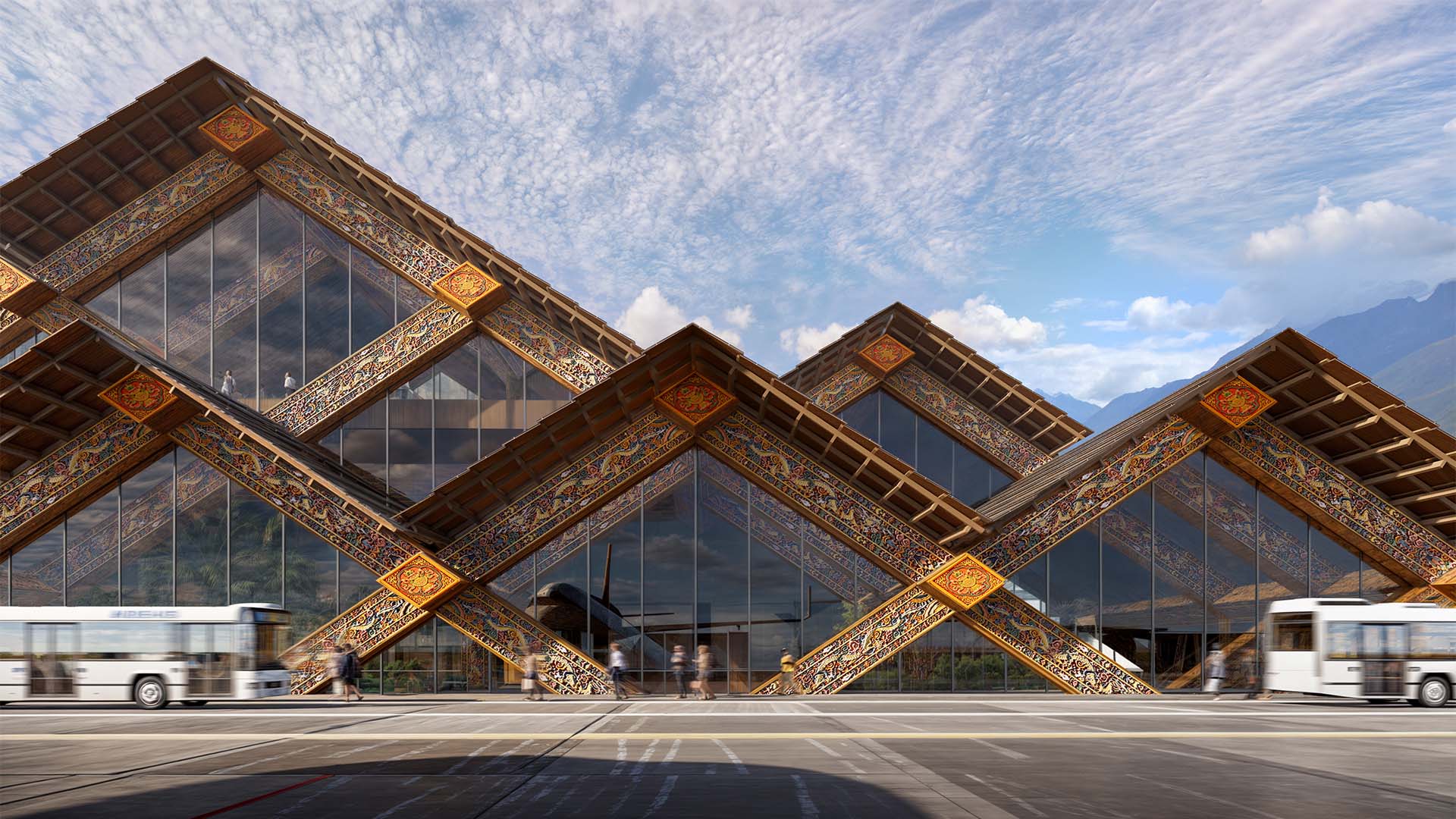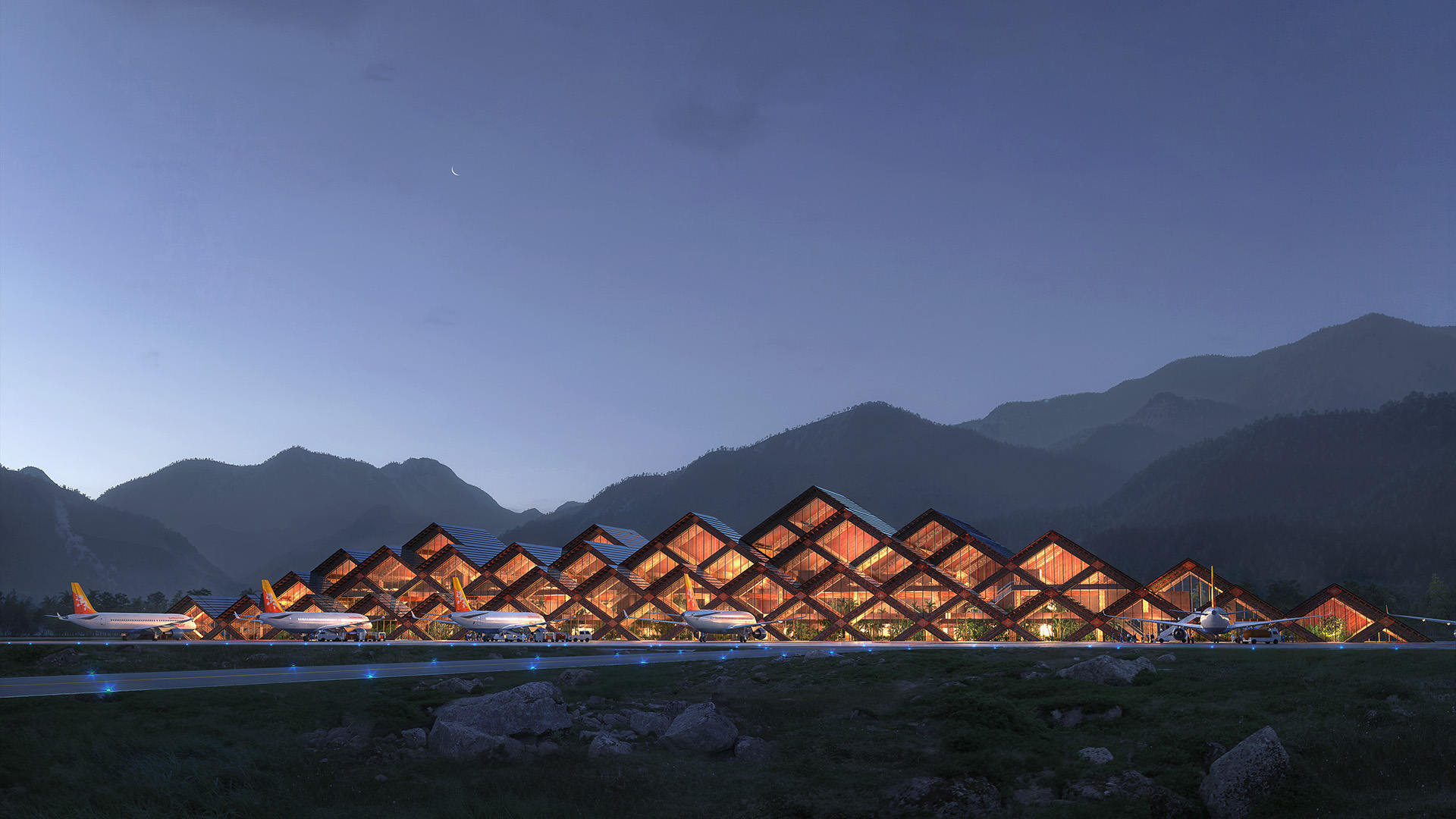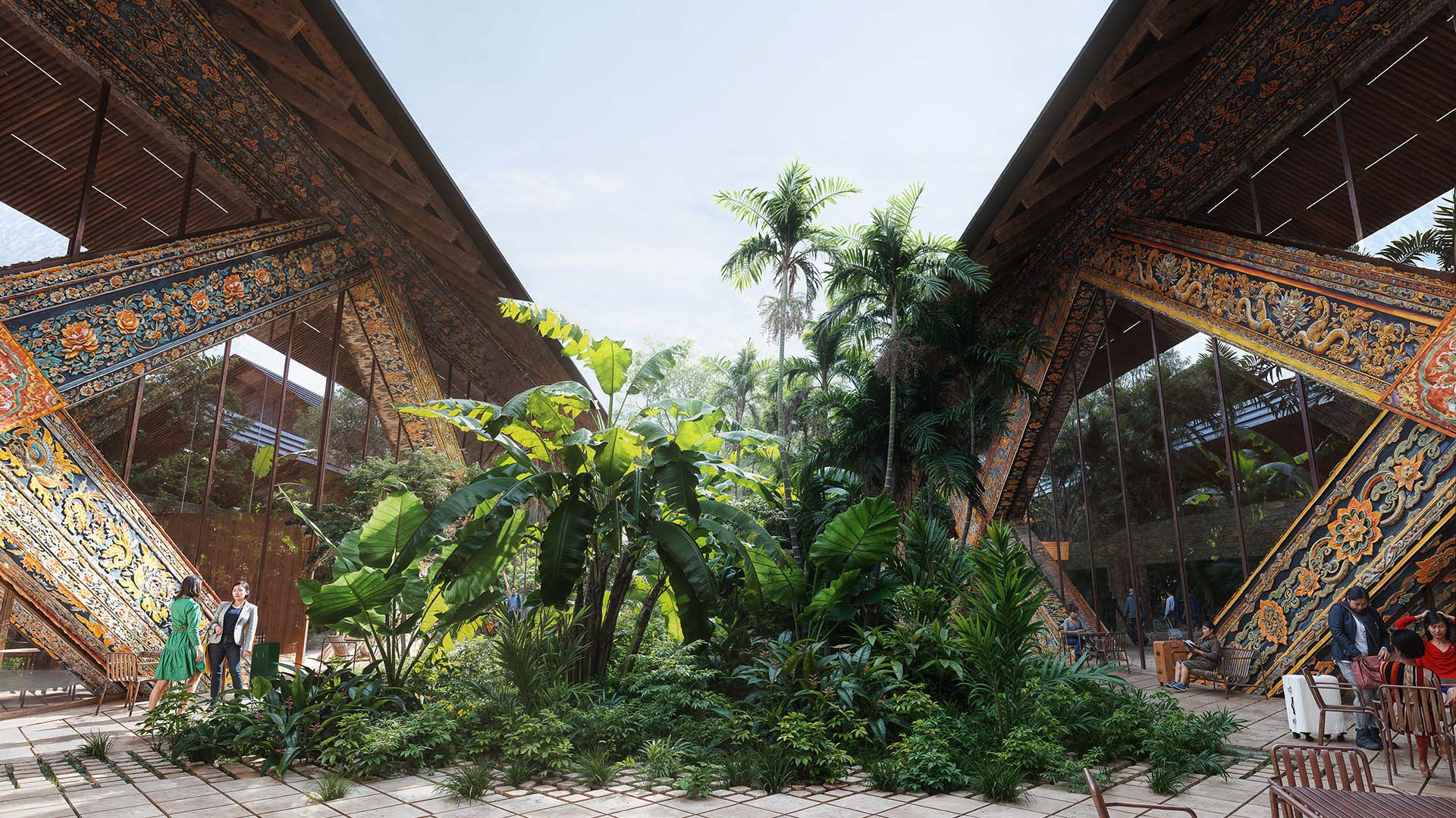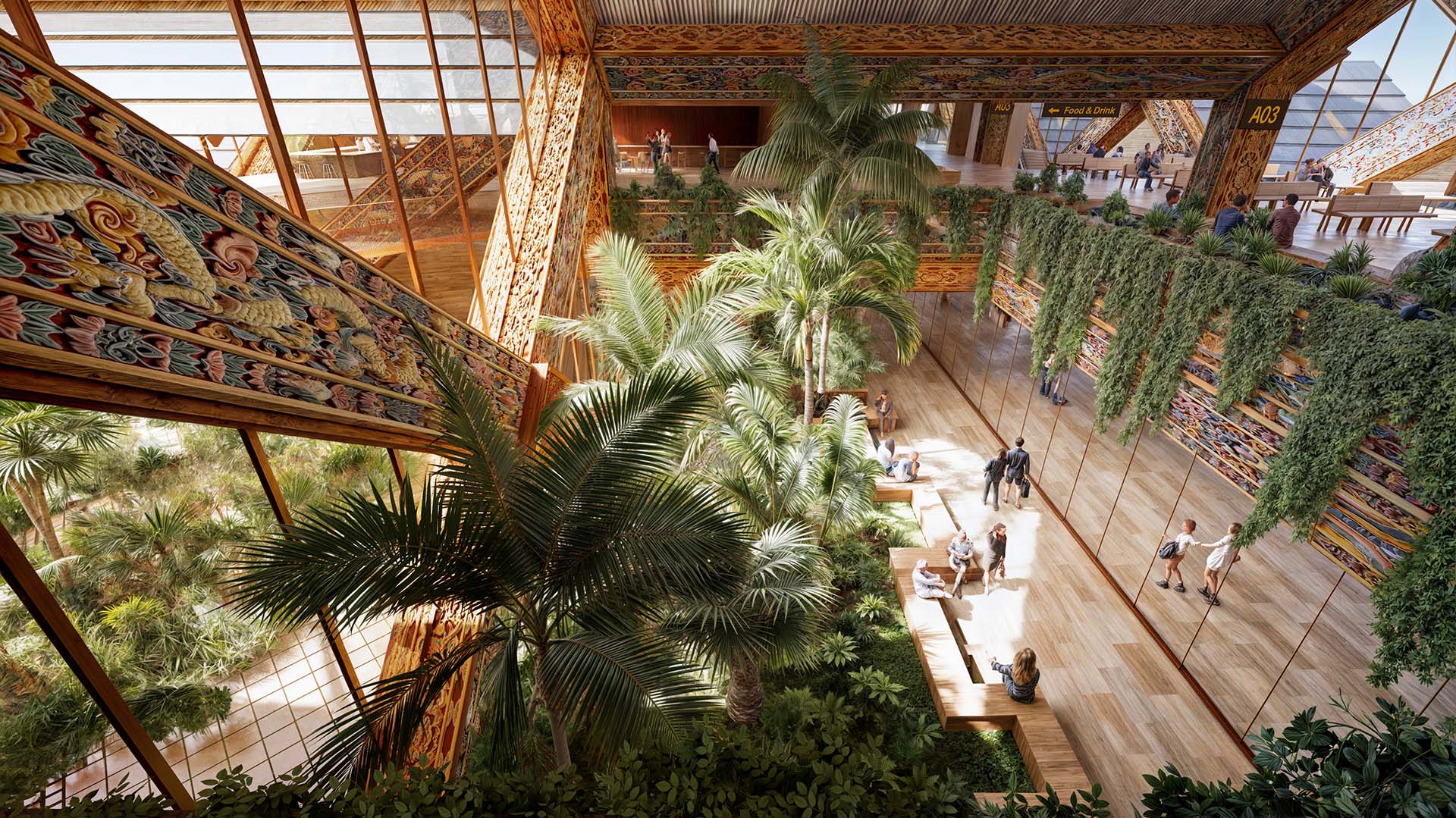
Gelephu Airport Apron View / Rendering: BIG-Bjarke Ingels Group
Imagine stepping off a plane into a space that seamlessly blends nature and culture, offering a harmonious experience unlike any other. Gelephu International Airport in Bhutan embodies this vision, combining traditional skills with modern innovation.
Nestled in the heart of Gelephu Mindfulness City (GMC), this airport is not just a transit hub—it’s a gateway to Bhutanese culture. Scheduled to open in 2029, it is designed to cater to travellers’ needs while honouring Bhutan’s rich cultural heritage.

Gelephu Airport Apron View / Rendering: BIG-Bjarke Ingels Group
The Strategic Importance of Gelephu’s Location
Gelephu’s proximity to the Indian border is a strategic advantage for Bhutan. It supports Bhutan’s national security and improves connectivity in this landlocked nation.
Unlike Paro International Airport, Gelephu’s flatter terrain is ideal for longer runways. This allows Gelephu to accommodate larger aircraft, creating opportunities for international flights that other Bhutan airports can’t handle.
His Majesty King Jigme Khesar Namgyel Wangchuck, King of Bhutan, highlighted the airport’s importance, saying, “Our immediate priority over the next five years is the construction of a large international airport in Gelephu, which will establish the GMC as a key aviation hub. This airport is essential for the success of the GMC as a business hub, and it is also a critical lifeline for Bhutan’s national security, especially for a landlocked country.”

Gelephu Airport Arrivals / Rendering: BIG-Bjarke Ingels Group
Overview of the Airport’s Design
At the heart of the airport’s design is its modular diagrid structure (diagonal grid framework). This unique architectural style uses sustainable glulam timber and features Bhutanese wood carvings. The design is not just about aesthetics; it also focuses on functionality and adaptability.
The layout is intuitive, guiding passengers smoothly from arrival to departure. The airport is spacious, covering 731,946 square feet (68,000 m²). It is projected to handle 1.3 million passengers annually by 2040. This capacity is essential for establishing Gelephu as a key aviation hub in the region.
As Bjarke Ingels, the founder of Bjarke Ingels Group (BIG), aptly stated, “An airport is the first and last impression you get of a place you visit. For the Gelephu International Airport, we have tried to embody the nature and culture of the country and the Mindfulness City. The forests that cover the highlands are allowed to flow from the arrival plaza through the airport all the way to the tarmac. Tropical trees provide shade for travelers, and the forest courtyard lines the main functions of immigration, security, and luggage. The airport architecture is composed of modular mass timber frames providing flexibility and expandability, resembling a stylized mountain range at a distance. Upon closer inspection, all the mass timber members are carved and colored according to traditional craft, adorned with three types of dragons representing the past, present, and future of Bhutan. The result is traditional yet avant-garde, forward-reaching and rooted. For me personally, this unusual embrace of traditional craft and color is a true testament to how affected I have been by my encounter with Bhutan – the country, its culture, and its people.”

Forest Spine / Rendering: BIG-Bjarke Ingels Group
Embodiment of Bhutan’s Artistic Heritage
One of the most captivating aspects of the airport is its seamless integration of traditional Bhutanese craftsmanship. The woodwork and carvings are not mere embellishments; they are the soul of the structure. The architects have ensured that the design honours Bhutan’s rich culture. For instance, the painted facade draws inspiration from the ‘Kachen,’ a revered wooden pillar in Bhutanese architecture. This connection to tradition is vital. It not only preserves the craft but also teaches future generations about their heritage.
As Frederik Lyng, a partner at BIG, said, “For the Gelephu International Airport, we wanted to create an experience that feels deeply Bhutanese – calm, welcoming, and connected to nature. The airport will provide an outstanding passenger experience, where generous daylit spaces, elements of the Bhutanese landscape, and the intricate carvings of the Bhutanese craftsmen go hand in hand to gently guide the passenger through the terminal.”
Sustainable Building Practices
In today’s world, sustainability is crucial. Gelephu embraces this principle wholeheartedly. The timber used in the construction is sourced sustainably, ensuring that the airport is in harmony with its natural surroundings.
The design incorporates climate-responsive architecture. For instance, the wooden structure helps regulate indoor humidity, while ventilated roofs promote natural airflow. Extended eaves provide shade, protecting travellers from heavy rainfall. This thoughtful approach not only improves passenger comfort but also aligns with Bhutan’s status as a carbon-negative nation.

Staff Logistics Entrance / Rendering: BIG-Bjarke Ingels Group
Integrating Nature: The Forest Spine and Passenger Experience
Gelephu in Bhutan is not just an airport; it’s a sanctuary of nature and mindfulness. At the heart of this innovative design is the Forest Spine, a unique feature that seamlessly integrates the beauty of Bhutan’s natural landscape into the airport experience.
The Forest Spine: A Natural Oasis
The Forest Spine serves as the central courtyard of the airport, dividing the terminal into two sections: domestic flights on the west and international flights on the east. This design is more than just functional. It creates a visual and physical connection to nature that is rare in airport buildings.
Travellers can enjoy a tranquil environment filled with indigenous flora and fauna. Imagine walking through a space where the lush greenery of Bhutan’s subtropical forests surrounds you. The Forest Spine is designed to evoke a sense of calm, allowing passengers to feel connected to the earth, even while travelling.
Passenger Comfort and Mental Well-Being
Gelephu Airport prioritizes passenger comfort and well-being in its design. Its intuitive layout features clear signs that guide travelers easily, reducing confusion. Natural light from expansive windows brightens the space, while gardens, green spaces, and a treetop walkway provide a refreshing escape from travel stress.
Mindfulness Lounges: A Space for Reflection
One of the standout features of the airport is its dedicated yoga and meditation lounges, thoughtfully designed to promote mindfulness and relaxation. Here, travellers can take a moment to recentre themselves before or after their flights. These lounges embody Bhutan’s cultural values of happiness and psychological well-being. They offer travellers a chance to pause, breathe, and reconnect amid travel chaos.

Green Mindfulness Lounge / Rendering: BIG-Bjarke Ingels Group
A Peek into the Future: The 2029 Launch of Gelephu International Airport
The airport is a collaboration between various entities, including the aviation engineering firm NACO. This partnership has resulted in a design that is not only innovative but also practical. The structural independence of the timber frames allows for future expansion without compromising the integrity of the original design.
Moreover, the airport will be showcased at the 2025 Venice Architecture Biennale, highlighting its significance on a global stage. This exhibition will feature a unique installation that merges tradition with innovation, celebrating Bhutan’s rich architectural heritage.
As Bhutan progresses, Gelephu Airport highlights the importance of preserving culture. It reminds us that, while embracing modernity, we should also respect our roots. The airport, opening in 2029, will be a landmark reflecting Bhutan’s spirit—connected to its past and looking towards the future.
